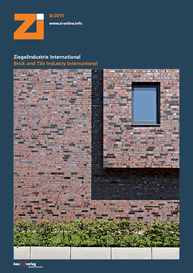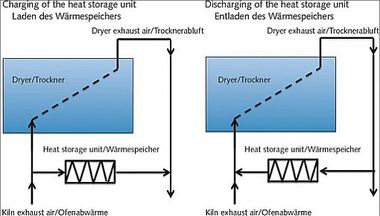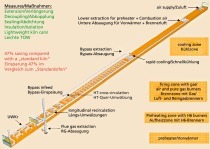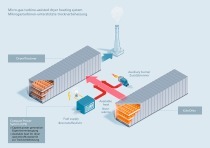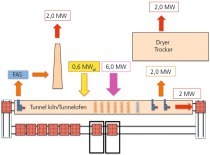Use of heat pumps in brick drying
For a brickworks with a production rate of 400 tonnes per day fired ware, the mixing water content of around 20 mass% necessary for pressing means that every day around 80 t water must be expelled from the green products and evaporated. At an energy demand of 4000 kJ/kgH2O, that corresponds to an energy equivalent of approximately 9000 m³ natural gas/day and it therefore constitutes the biggest energy loss stream in the brickworks.
The energy fed to the dryer usually consists of the enthalpy stream, of the hot air extracted from the cooling zone of the tunnel kiln. Energy is supplied to the dryer at the expense of the fuel fed to the kiln.
Combined heating incorporating the cooling zone network brings energy disadvantages in plants in which production only runs five days a week. Here too the air from the kiln is available on seven days. Corresponding to the weekly shares, up to 30 % losses from this co-energy result and that is when the cooling zone network supplies the entire dryer energy. A reduction of this combined air quantity, e.g. with the hot air being used extensively in the kiln process, leads first to an energy bottleneck in the energy supply to the dryer in the second half of the week, when the energy demand is highest.
Reduction of the specific energy necessary for drying can be achieved first with an increase in the heat and material transfer between the dryer atmosphere and drying products, and second with the optimization of the interaction of ambient air, supplied air and waste air situation. Following this optimization, subsequent use of the dryer waste heat by means of recuperation is feasible. Problematic, however, is the low temperature of the air made available. If it is possible to recover the condensation heat present in the humid waste air and bring the air to a higher temperature level with the help of a heat pump, recovery of the energy from the drying process is possible. Owing to the different waste air situations, a differentiation must be made between continuous and chamber dryers. The IZF is working together with five other German institutes and the University of Ghent, Belgium, on a possible solution.
Dipl.-Ing. Eckhard Rimpel, Institut für Ziegelforschung Essen e.V.


